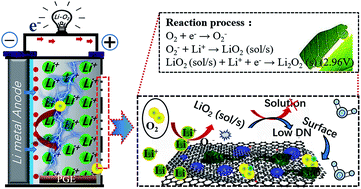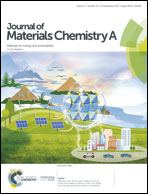Rational design of a hierarchical N-doped graphene-supported catalyst for highly energy-efficient lithium–oxygen batteries†
Abstract
Integrating carbonaceous materials with metal oxides to construct a robust 3D network is a powerful yet challenging option to improve the performance of Li–O2 batteries. Herein, a facile bottom-up method was developed to prepare N-doped graphene strengthened by cross-linked uniform cobalt oxide nanoparticles. This distinctive structure provided essential properties for oxygen cathodes, including an intrinsically high catalytic activity, inherently open active sites, large accessible surface areas, and a continuous porous nature for the accommodation of discharge products. Consequently, it was observed that this interesting nanostructure manifested a satisfying oxidation activity towards Li2CO3 and LiOH within the stability window of the electrolyte, which outperformed the commercial Ru/C (5%) catalyst. Also, cell measurements revealed that a superior capacity and comparable cycling performance were achieved with the discussed complex electrode in pure O2, N2, CO2 and even ambient air. As such, the present study rationalized the great potential of the fabricated N-enriched graphene-dispersed catalyst in the transition from Li–O2 to Li–air batteries.



 Please wait while we load your content...
Please wait while we load your content...